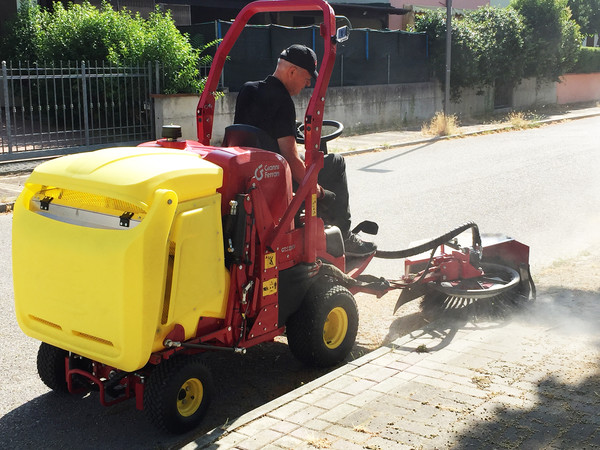
Thermal and mechanical weeding in urban environments
In urban areas, it is not possible to use chemically synthesized phytopharmaceuticals to perform weed control in corners and edges of sidewalks, cracks in paved surfaces, pavement joints, or unpaved streets. However, mechanical or thermal technologies are available to eliminate these weeds
The grass growing in the city in the corners and edges of sidewalks, in the cracks of paved surfaces, in the joints of cobblestones or the unpaved lanes of parks and gardens, as in flower beds, deprives urban areas of their decor. Weeding these surfaces is an operation comparable to street and sidewalk cleaning that needs to be carried out since they are places of public contact without synthetic chemical pesticides. Therefore, weeding with full respect for environmental sustainability. For these surfaces, weeding by mechanical or thermal means can be used.
Mechanical weed control. On stabilized but permeable surfaces (rammed earth, gravel roads, etc.) and for a not very extensive infestation, a superficial intervention, at a depth of a few millimeters, with a kind of light metal rake that uproots the unwanted weeds may be enough. The tool can be mounted at the rear of a compact or walking tractor. Three or four passes per year are usually needed to get good results. Combination tools can also be used, such as a surface colter and a light-mesh harrow. Mechanical intervention is carried out on paved or otherwise covered water-resistant surfaces with rotating circular brushes mounted on a self-propelled vehicle with a driver on board or on the ground. Brushes can have different types of filaments. Steel filaments are particularly suitable for removing leathery weeds resistant to eradication. In addition, these brushes also perform good cleaning of organic material left on the ground by dogs taken for a walk. They range from 40 cm to 1 meter in diameter, with a rotation speed of 50 to 200 rpm. A different type of brush is the mixed type, that is, with filaments of metal and plastic material. However, their action is not as strong as that of wire brushes. The lifespan of these brushes depends on the hours of use over a year but usually does not reach 100. Nylon and polyethylene brushes are used mainly for less demanding weeding operations.
Thermal weed control. When using thermal weeding, the aerial parts of weeds are devitalized by heat shock, which leads to the rupture of plant tissue cells. A variety of techniques are adopted by: hot water, hot water and foam, water steam, hot air, pyroweeding, infrared weeding. Hot water weeding involves spraying water directly on the weeds at a temperature of 95-120°C. Within seconds, the water attacks the leaf apparatus, and the effect of the temperature is transmitted to the inside of the plant and the root system. The result of the treatment is seen after 18-24 hours. The key parts of the equipment are a tank, a diesel boiler, a 24-volt electric pump with a battery, and a manually operated lance or spray boom. This system also makes it possible to reach areas that are not easily accessible and to carry out treatment around trees, at the foot of walls or in tight corners of sidewalks. Some self-propelled versions and versions can be manually moved and towed or applied on trailers. Tank capacity ranges from 300 to 1,000 liters. Boiling water consumption is between 100 and 150 liters per hour, corresponding to an operating power of 300 to 2,000 m2 per hour. Treatment is carried out at a working pressure of up to 8 bar. The newest generation of machinery has high efficiency, which allows the tank capacity to be reduced for the same yield. For the treatment to be effective, it is necessary to repeat the procedure 3-5 times a year, every 5-6 weeks. This machine is also manufactured with a battery boiler instead of a diesel boiler.
Along with the herbicidal action of boiling water, foam, which is generally composed of canola oil, corn oil, etc., has been added. Dispensed by machinery designed by some manufacturers, the foam is injected under pressure into the area to be treated to a depth of 3 cm. The operating principle is the same as for boiling water, which is the breaking of plant cell walls with the involvement of the root system.
In water vapor weeding, the vapor is produced by heating water in a boiler and then delivered at a temperature of about 100 °C with a lance or weed killer bar. Again, this results in the degradation of the cellular structure with subsequent plant desiccation. This treatment does not attack the root system unless action is taken when the weed is in the seedling stage.
A pulsating hot air weed killer basically consists of a propane cylinder mounted on a cart and a piezoelectrically ignited thermal lance. The air heated by the flame comes out at an adjustable pressure between 1 and 2 bar. A 10-kg cylinder gives a range of 4-5 hours. The high air temperature causes the weeds to dry up. The effect is visible after about 24 hours.
Pyroweeding acts by heat (300-1,200 °C) exerted by an open flame applied a few centimeters from the weed briefly. The heat stroke acts on the water content of the weed's plant tissues and results not in burning (unless the plants are dry) but in wilting. One variation is infrared weeding. The flame strikes a ceramic plate, and the infrared rays desiccate the weed by thermal shock.
Closing remarks. In order to protect public health and reduce air and water pollution, synthetic pesticides of chemical origin can no longer be used in weed control in urban areas. This brief review shows that there is no single alternative method to chemical weed control but rather several. Choosing among the different possibilities should be done carefully, taking into account not only agronomic but also urban and social parameters.








